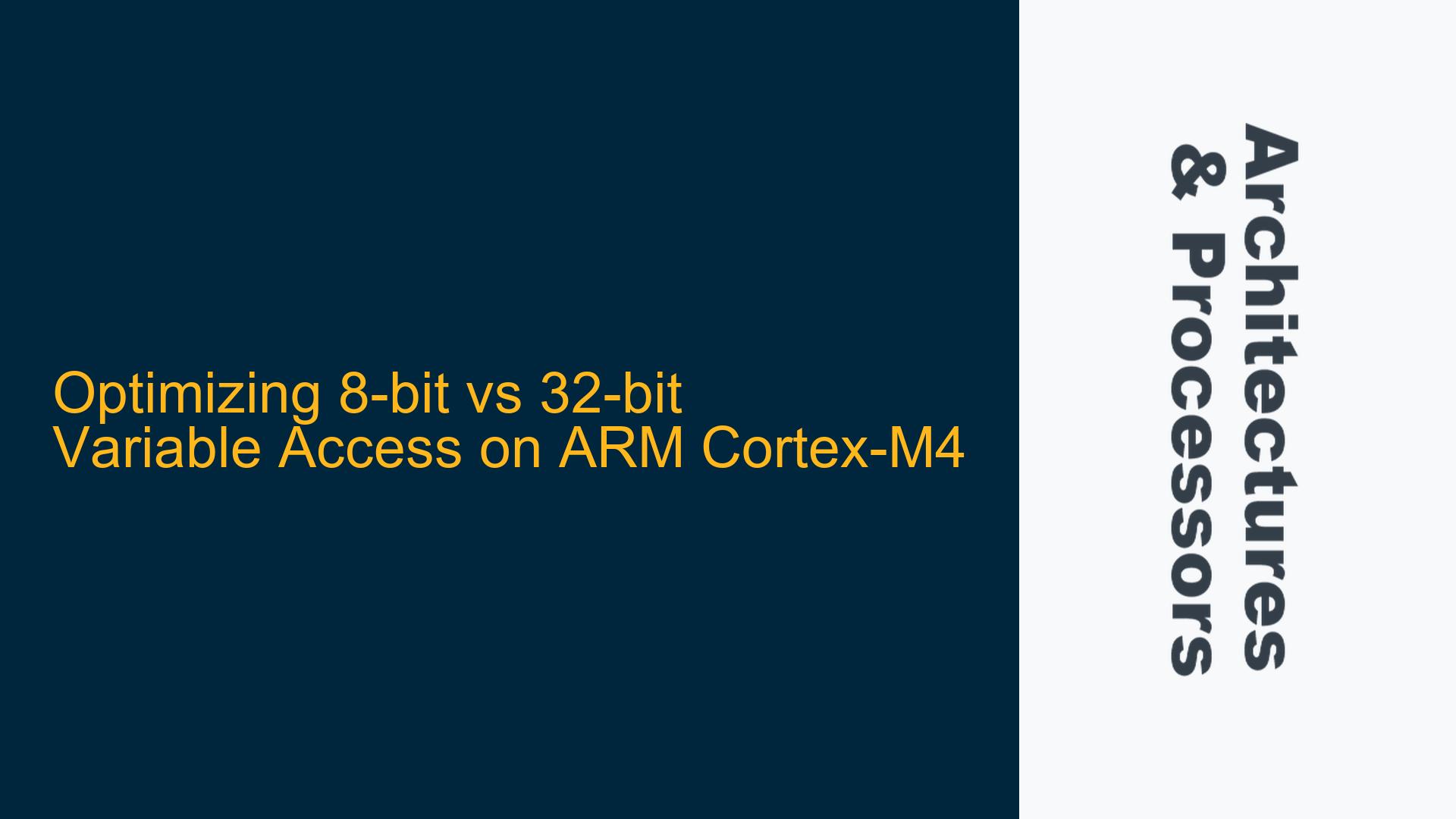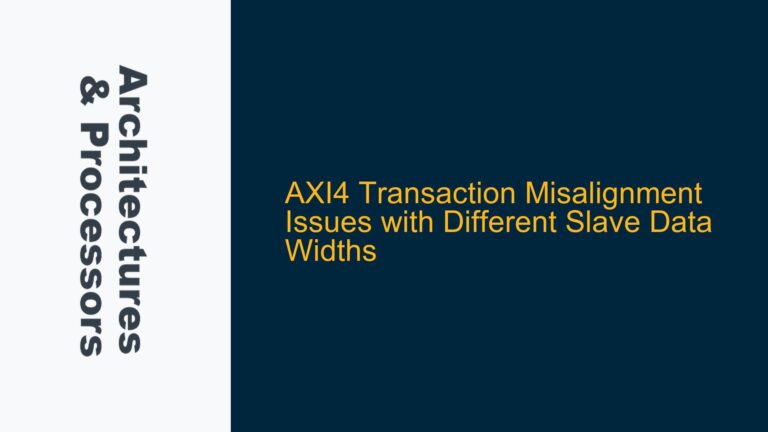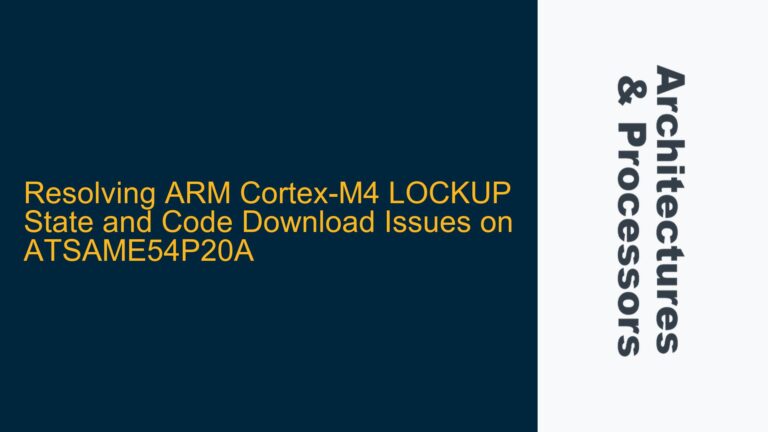ARM Cortex-M4 Memory Access Mechanics for 8-bit and 32-bit Variables
The ARM Cortex-M4, a 32-bit microcontroller based on the ARMv7-M architecture, is designed to handle 32-bit data natively. However, it also supports 8-bit (byte) and 16-bit (halfword) data types through specific load and store instructions. Understanding how the Cortex-M4 manages different data sizes is critical for optimizing performance, especially in resource-constrained embedded systems.
When dealing with 8-bit variables, such as uint8_t, the Cortex-M4 uses the LDRB (Load Register Byte) and STRB (Store Register Byte) instructions. For 32-bit variables, such as uint32_t, it uses LDR (Load Register) and STR (Store Register). At first glance, one might assume that using 32-bit variables would always be faster due to the processor’s native word size. However, the reality is more nuanced, as the Cortex-M4’s instruction set and memory subsystem are optimized to handle smaller data types efficiently.
The Cortex-M4’s memory system is byte-addressable, meaning each byte in memory has a unique address. When a 32-bit variable is accessed, the processor reads or writes all four bytes at once. For 8-bit variables, only the relevant byte is accessed. Despite this difference, the Cortex-M4’s instruction timings for LDRB, LDRH, and LDR are identical in many cases, as highlighted in the ARM Technical Reference Manual (TRM). This means that, in terms of clock cycles, accessing an 8-bit variable can be just as fast as accessing a 32-bit variable.
However, the performance implications extend beyond just instruction timings. The alignment of data in memory, the presence of other data in the same word, and the potential need for read-modify-write operations can all influence the overall efficiency of accessing 8-bit variables. For example, if an 8-bit variable shares a 32-bit word with other data, modifying the 8-bit variable requires a read-modify-write sequence to preserve the other 24 bits. This additional overhead can negate the apparent simplicity of using smaller data types.
Read-Modify-Write Overhead and Multi-Core Considerations
One of the key challenges when using 8-bit variables on a 32-bit architecture like the Cortex-M4 is the potential need for read-modify-write operations. These operations are required when modifying a portion of a 32-bit word without affecting the rest of the word. For example, if an 8-bit flag is stored in the least significant byte of a 32-bit word, and the upper 24 bits contain other valid data, updating the flag requires the following steps:
- Read the entire 32-bit word into a register.
- Modify the specific byte in the register.
- Write the updated 32-bit word back to memory.
This sequence ensures that the other 24 bits of data remain unchanged. However, it introduces additional overhead compared to directly writing a 32-bit variable, which can be updated in a single operation.
In multi-core systems or systems with DMA (Direct Memory Access), read-modify-write operations can also lead to race conditions if proper synchronization mechanisms are not in place. For instance, if one core is performing a read-modify-write operation on a shared 32-bit word while another core or DMA controller attempts to modify the same word, data corruption can occur. To prevent this, the Cortex-M4 provides exclusive access instructions, such as LDREXB (Load Register Exclusive Byte) and STREXB (Store Register Exclusive Byte), which ensure atomicity for byte-sized data.
Despite these challenges, there are scenarios where using 8-bit variables is advantageous. For example, when memory is at a premium, using 8-bit variables can significantly reduce the overall memory footprint of an application. Additionally, in systems where data is naturally byte-oriented, such as communication protocols, using 8-bit variables can simplify code and improve readability.
Implementing Efficient 8-bit Variable Access on Cortex-M4
To optimize the use of 8-bit variables on the Cortex-M4, developers should consider the following strategies:
-
Data Alignment and Padding: Ensure that 8-bit variables are aligned in memory to minimize the need for read-modify-write operations. If an 8-bit variable is frequently accessed, consider placing it in a word-aligned memory location where it does not share space with other critical data. This allows the variable to be accessed directly without affecting neighboring data.
-
Use of Exclusive Access Instructions: In multi-core or DMA-enabled systems, use exclusive access instructions (
LDREXBandSTREXB) to ensure atomic updates to 8-bit variables. These instructions prevent race conditions by allowing only one core or DMA controller to modify the variable at a time. -
Memory Layout Optimization: Group related 8-bit variables together in memory to reduce fragmentation and improve cache efficiency. For example, if multiple flags are used in a state machine, store them in a contiguous block of memory to enable efficient access patterns.
-
Compiler Optimizations: Leverage compiler optimizations to minimize the overhead of accessing 8-bit variables. Modern compilers, such as ARM GCC and ARM Clang, can automatically optimize memory access patterns and instruction sequences for 8-bit variables. Ensure that the compiler is configured to generate code tailored for the Cortex-M4 architecture.
-
Profiling and Benchmarking: Use profiling tools to measure the performance impact of using 8-bit variables in your specific application. Identify hotspots where read-modify-write operations or misaligned data access are causing performance bottlenecks, and apply targeted optimizations.
-
Hybrid Approaches: In some cases, a hybrid approach that combines 8-bit and 32-bit variables may be optimal. For example, use 8-bit variables for flags and small counters, while reserving 32-bit variables for performance-critical data. This approach balances memory efficiency with access speed.
By carefully considering these strategies, developers can effectively manage 8-bit variables on the Cortex-M4 without sacrificing performance or reliability. While the Cortex-M4 is inherently optimized for 32-bit data, its support for smaller data types, combined with thoughtful design and optimization, enables efficient handling of 8-bit variables in a wide range of applications.
Conclusion
The ARM Cortex-M4’s architecture provides robust support for both 8-bit and 32-bit variables, with each data type offering unique advantages and challenges. While 32-bit variables align naturally with the processor’s native word size and can be accessed efficiently, 8-bit variables offer memory savings and are well-suited for specific use cases, such as flags and small counters. However, the potential need for read-modify-write operations and the risk of race conditions in multi-core systems require careful consideration and optimization.
By understanding the Cortex-M4’s memory access mechanics, leveraging exclusive access instructions, and applying targeted optimizations, developers can achieve efficient and reliable performance when using 8-bit variables. Whether optimizing for memory footprint, access speed, or code readability, the Cortex-M4’s flexibility ensures that 8-bit variables can be effectively integrated into a wide range of embedded applications.






